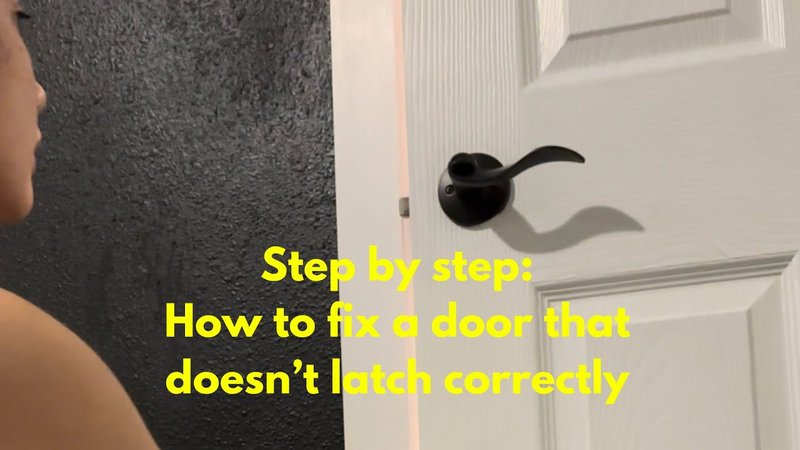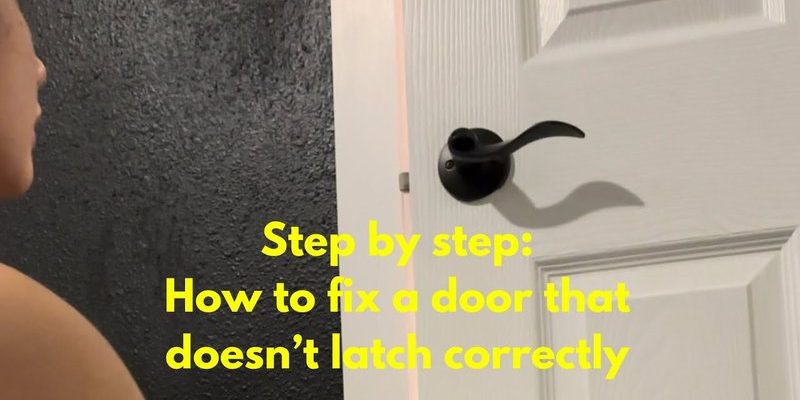
A handleset that won’t latch properly isn’t just a minor nuisance. Over time, coming home to a door that pops back open or has to be yanked shut can get under your skin. Maybe you’ve tried a hit-and-miss fix—jiggling the handle, tightening screws, or slamming the door a little harder. Sometimes it works, but the underlying problem doesn’t go away. The good news? Most handleset latching problems are pretty straightforward to tackle, once you break it down step by step.
You don’t have to be a DIY rockstar to get your handleset working smoothly again. Whether your lockset uses a traditional latch or a fancy electronic remote system, the basic troubleshooting steps are surprisingly approachable. So, let’s dig in and get your door closing like it should—secure, smooth, and drama-free.
What Causes a Handleset Latch to Stop Working?
The most common reasons your handleset won’t latch properly are usually mechanical, and sometimes frustratingly simple. Honestly, nine times out of ten, it comes down to either the latch or strike plate being out of alignment. Over the years, doors shift, hinges loosen, and wood swells because of humidity. That can nudge everything just enough to throw off that neat “click” when the door shuts.
Sometimes, the handleset mechanism inside the door just wears out. Springs lose their bounce, latches get sticky, or—especially with electronic locks—something might go wrong inside the code or battery compartment. For brands like Kwikset or Schlage, their latches are sturdy but not immune to regular wear and tear.
Another thing to check: the way the door sits in the frame. If your door is sagging, even a little, the latch won’t line up with the strike plate. You might notice the handle has to be lifted or pushed down awkwardly. That’s almost always a hint that physical alignment is off—not necessarily an issue with the lock code, battery, or electronic remote (if you have one).
Let me explain: Think of your lock as a small puzzle where every part needs to fit exactly right. If the puzzle shifts, even a millimeter, the whole thing works less reliably. That’s why a slow, detailed approach to troubleshooting is key.
Checking the Handleset for Loose or Damaged Parts
Before jumping into complicated fixes, start with the basics: is anything obviously loose or wobbly? Grab a screwdriver and check the screws on the handleset plate inside and outside your door. Over time, vibrations (and maybe a few slammed doors) can cause these to back out just enough to mess up the mechanism.
If you have an electronic system, gently remove the battery cover and look for broken tabs or wires. Sometimes, the fault is just a weak battery or a loose connection, especially if your lock isn’t responding to its remote or code panel.
Pay attention to how the latch moves when you turn the handle. If it sticks or feels gritty, there’s probably dirt or old lubricant blocking the way. For brand-specific handlesets, like those from Yale or Kwikset, you’ll often find little diagrams under the plate showing proper alignment—peek at those if you’re not sure what goes where.
Double check for wear and tear on the latch bolt itself. A rounded or chipped latch might not catch the strike plate, no matter how well the rest of the system is set up. Here’s the thing: Even a little damage can throw off the whole locking process.
Testing Door Alignment and Strike Plate Position
This part can feel tedious, but it’s honestly the heart of most handleset troubleshooting. With the door closed, look at the gap between the door and the frame, especially around the latch area. A gap that’s too wide, too narrow, or uneven can stop your handleset from latching.
Try this: Slowly close the door and watch as the latch meets the strike plate. Does it hit too high or too low? If you see scrape marks or paint rubbing off either side, the latch and strike aren’t properly lined up.
- If the latch is missing the hole: You may need to adjust the strike plate up or down. Loosen the screws just a little, shift the plate until the latch lines up, and retighten.
- If the latch is stiff or won’t spring out: Test if the latch works freely when the door is open. If it does, alignment is your issue. If not, you’re dealing with internal handleset problems.
- For doors that drag or sag: Tighten the hinge screws or shim the hinges to lift the door. Sometimes, the smallest tweak can get everything working again.
If you have an electronic lock with a remote or code pad, also check that the mechanism isn’t trying to throw the bolt when it’s obstructed. Over time, alignment issues can wear on the electronics and drain the battery faster.
Cleaning and Lubricating the Handleset Mechanism
You might be wondering how much grime can actually build up inside a door lock. The answer? More than you’d guess. Handlesets—especially older ones—can collect dust, lint, and even tiny metal shavings. This makes the latch sticky and harder to operate, which can stop it from snapping back into the strike.
Here’s what I recommend: With the handleset removed (or while working from the side), grab a clean rag and wipe down the latch and strike plate. For stubborn gunk, a little mild soap and water works, but keep things dry to avoid rust.
For lubrication, use a graphite or silicone spray. Avoid oil-based sprays like WD-40 for most household locks—they can attract dirt over time. If you’re working with a more advanced system (think Schlage’s electronic handleset), check the brand’s manual to see what lubrication is safe.
Don’t forget: A little lubricant goes a long way. Work the handle a few times to spread it evenly. Once everything’s clean, you might find your latching problem magically disappears.
If you maintain your handleset once a year, you’ll probably never have to deal with stubborn latching again. Prevention makes troubleshooting way less stressful.
Diagnosing Issues with Electronic or Remote Handlesets
Handlesets with keypads, remotes, or smart features can add a whole new set of troubleshooting steps. If your electronic lock isn’t latching, don’t panic—most problems are still mechanical at heart. But you’ll want to check the electronics too.
First, check the batteries. Weak batteries can cause the lock to lose power before it fully retracts the latch, leaving your door half-open. Most brands (like Kwikset and Yale) have low battery indicators, but sometimes the warning comes too late.
If the handleset works fine with a key but not the code or remote, try resetting the lock. Look for a small reset button under the battery cover or consult your brand’s manual for sync or pairing steps.
- Remote won’t work: Try re-pairing the remote or keypad. Electronic interference, a dead battery, or a lost connection are common issues.
- Code pad doesn’t respond: Double check the code entry, replace batteries, or reset the device.
- Electronic latch sounds “weak” or “tired”: Replace the batteries or check for debris binding the latch.
For advanced troubleshooting, you may need to disassemble the handle and inspect the motor or circuit board. If your lock is under warranty, reach out to the manufacturer before going too far.
Replacing or Adjusting the Latch and Strike Plate
If you’ve checked alignment, cleaned, and lubed everything, but your handleset still won’t latch, it might be time to replace the latch or adjust the strike plate more significantly. Honestly, this sounds scarier than it is.
Start by removing the old latch—usually just two screws on the edge of the door. Bring the old piece to the hardware store to match the size. Make sure to choose a replacement from the same brand (Schlage, Kwikset, Yale, etc.) if possible, for the best fit.
When re-installing, double check the latch orientation. If it’s backwards, the bevel won’t guide the latch into the strike plate. This is a super common mix-up.
If the strike plate hole is too small or off-center, trace around where the latch actually hits and carefully chisel the opening wider. Don’t rush—small adjustments are better than big mistakes. For metal doors, use a metal file instead of a chisel.
If you’re still struggling, universal replacement latches exist, but they’re not always a perfect fit. Sticking with the original brand makes troubleshooting and future repairs a whole lot easier.
When to Call a Locksmith or Replace the Handleset
Sometimes, despite your best efforts, a handleset just won’t behave. If you’ve tightened, cleaned, adjusted, and even replaced parts but the latch still doesn’t catch, it could be time to call in a pro.
- The internal mechanism is jammed or broken.
- The electronic components have failed, even after a reset.
- The door frame is warped beyond a simple hinge adjustment.
- Security is at risk and you need a reliable fix right away.
Honestly, there’s no shame in asking for expert help—especially if your handleset is an expensive model or part of a smart home system. A locksmith can quickly diagnose subtle issues, like a bent spindle or misaligned code mechanism, without you having to disassemble everything.
If repairs start looking more expensive than a replacement, consider swapping out your old handleset for a new one, possibly with upgraded features like remote locking, code entry, or better weather resistance. Just weigh whether the hassle (and cost) is worth it for your door and family’s needs.
Keeping Your Handleset Working Smoothly
Once your handleset is latching properly again, a little preventive care will go a long way. Make it a habit to check the screws and lubricate the latch twice a year—spring and fall are perfect reminders. If your door gets a lot of sun or moisture, inspect the alignment every few months to catch small shifts early.
If you’re using an electronic handleset, keep a fresh set of batteries handy, and make sure everyone who uses the door knows how to reset or sync the remote and code, just in case.
Here’s a simple maintenance checklist:
- Tighten all handleset and hinge screws regularly.
- Lubricate the latch and moving parts with graphite or silicone spray.
- Clean the strike plate and latch area to keep debris away.
- Test the lock with both the key and electronic components every few weeks.
If you stay on top of these little things, your handleset will keep your door secure and stress-free—and you’ll spend less time troubleshooting down the road.
A handleset that won’t latch properly can be a real headache, but with a careful, step-by-step approach, most problems can be solved without special tools or experience. Whether you’re adjusting the strike plate, giving the mechanism a good clean, or swapping out a stubborn part, you’re investing in your home’s security and your own peace of mind.
If you ever get stuck, remember: even the pros started as beginners, and every little victory—like that perfect “click” when the door latches—is worth celebrating. Fixing your handleset is just another way of making sure your home welcomes you in and keeps trouble out.
